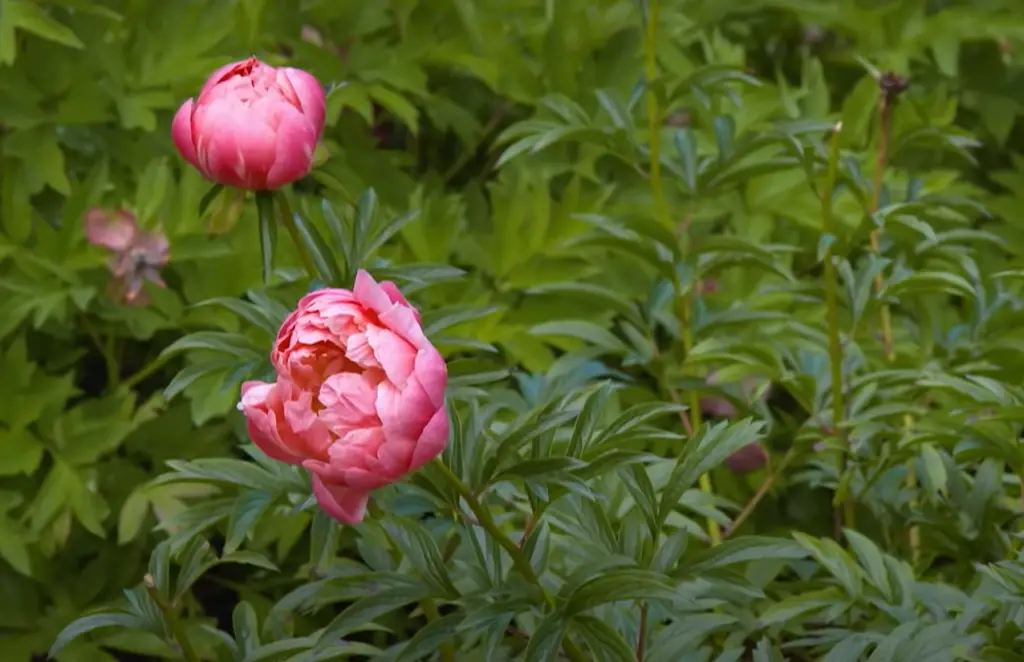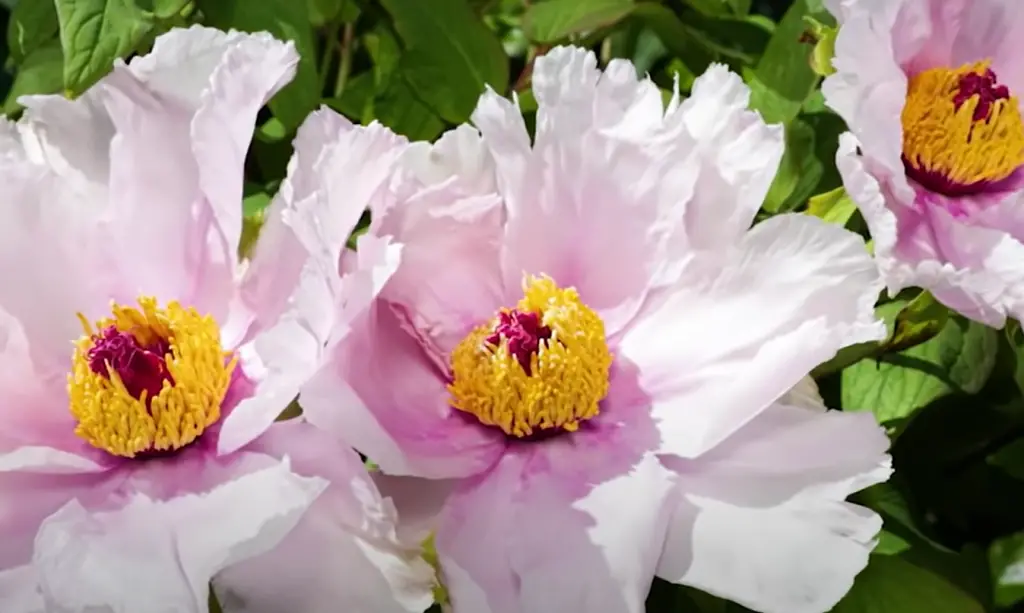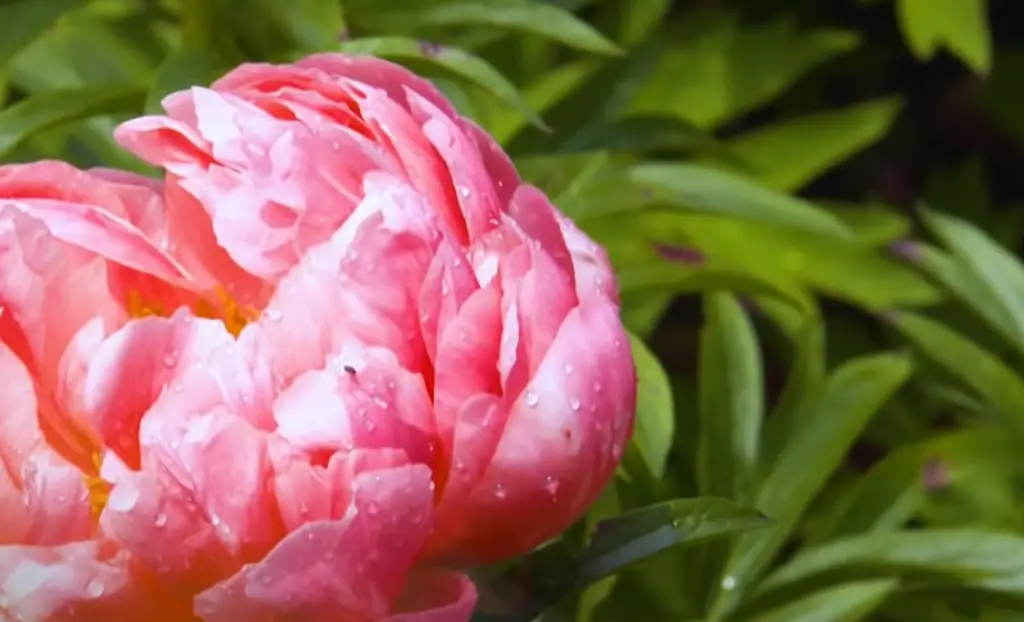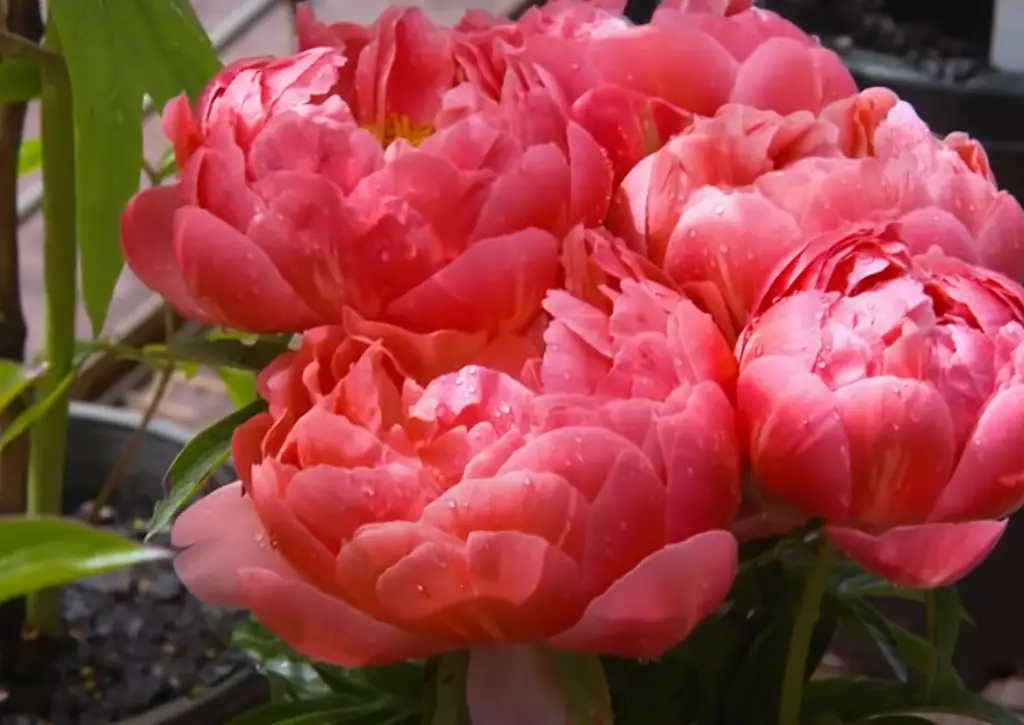Are you finding your peony leaves beginning to curl? You’re not alone: it’s a common problem for both the novice and experienced gardener alike. Luckily, there are straightforward measures that can prevent this problem or revive your cherished flowers when their leaves start curling. In this blog post we’ll cover exactly what causes peony leaves to curl – as well as how to solve the issue with helpful advice tailored specifically for these plants. With a bit of knowledge and effort, you can ensure that those beautiful pink petals keep gracing your garden all summer long!
What Causes Peony Leaves to Curl?
Watering Issues
Improper watering, whether excessive or insufficient, can lead to the curling of peony leaves.

If you have been overwatering, then reduce the amount of water given to the plant and allow it more time to dry out between waterings. If you have been underwatering, then increase the amount of water given and ensure that there is adequate drainage in your soil.
Lack of Shade
Peonies need some shade to protect their leaves from the sun. Make sure your peony is planted in an area that gets some shade during the hottest part of the day. If it’s not, consider providing that shade with a trellis or awning over the plant. This will reduce the amount of direct sunlight and help keep your peony’s leaves from curling up. [1]
Extreme Temperature Changes
Peonies are very sensitive to temperature. When the day is too hot and the night is too cold, it causes the leaves of peonies to curl up. Ensure that your peony is planted in a location where it experiences consistent temperatures throughout the day. This will contribute to the optimal growth and health of the plant. If you experience sudden temperature changes in your area, you may need to provide some additional protection for your plant, such as covering it with light fabric or an old blanket during extreme weather events.
Lack of Nutrients
Peonies need nitrogen, phosphorus and potassium – the three major nutrients for growth and flowering. A deficiency of any or all of these can cause leaf curling in peonies. You can determine a nutrient deficiency by testing the soil with a soil test kit or contacting a local agricultural extension office for advice. If your peony’s leaves are curling due to lack of nutrients, fertilize accordingly following label instructions or consult your local horticulturalist for advice.
Pests and Diseases
Peony leaves curling can also be caused by pests and diseases.
If you suspect a pest problem, use insecticidal soap or neem oil to control infestations of aphids or spider mites. To effectively treat fungal and bacterial infections, it is recommended to use sprays specifically designed to target fungi or bacteria. These specialized fungicide or bactericide sprays provide the most effective treatment options for combating these types of infections. Be sure to follow the instructions on the label carefully for best results.[2]Transplant Shock
If you recently transplanted your peonies, they may be going through transplant shock. Transplant shock is caused by the trauma of being moved from one location to another and can cause leaves to curl up as a reaction.

To help your peony recover, water it regularly and keep it in a sunny spot with adequate protection from wind. The curled leaves should start to uncurl within a few weeks.
Low Humidity
Peonies tend to curl their leaves when the humidity is too low. If you suspect this may be an issue, try setting up a humidifier near your peony plants or misting them regularly with water. Furthermore, incorporating a layer of mulch around the plant’s base serves to retain moisture and shield against extreme temperatures. This practice not only helps with water retention but also provides insulation, contributing to the overall well-being of the plant.
How Do You Uncurl Your Peony Leaves?
One effective way to uncurl peony leaves is to spray them with a fungicide. Fungicides are chemicals that kill fungi, which can be the cause of leaf curling in some cases.
You should also inspect your plants for any visible signs of pests or disease and remove them if necessary. If you find aphids, scale insects, thrips, spider mites, or other pests on the leaves, treat them with an appropriate insecticidal soap or horticultural oil according to the instructions on the label.
If you’re dealing with a fungal infection such as powdery mildew or rust spots on your peonies, prune off affected leaves and spray the remaining foliage with a fungicide. When pruning, be sure to sanitize your pruners in between cuts by dipping them into rubbing alcohol or a solution of nine parts water and one part bleach.
Ensure that your plants receive an ample amount of sunlight and benefit from proper air circulation. For optimal growth, peonies require a minimum of six hours of direct sunlight each day. If you notice that your plants are not getting enough light, consider relocating them to a sunnier area in your garden. This simple adjustment will ensure their well-being and enhance their overall beauty. You should also avoid wetting the foliage when watering; instead, water at the base of the plant to reduce leaf moisture levels which can encourage fungal diseases. [3]
By following these steps, you can help ensure healthy peony leaves and blooms. With the right care, you’ll be able to enjoy your peonies for years to come!
Tips For Growing Healthy And Beautiful Peonies
- Plant peonies in a location that receives at least 6 hours of sunlight each day. Peonies thrive in well-drained soil and need plenty of sun to flower properly.
- Fertilize your peony plants regularly with a balanced fertilizer formulated for flowering plants, like 10-10-10 or 5-10-5. This will help the plant produce more blooms and promote healthier foliage growth.
- Water your peonies deeply once a week during the growing season. During dry spells or periods of drought, water them twice a week to keep their roots from drying out completely. Make sure not to overwater, as this can cause root rot and other issues with the plant.
- Cut off any spent flowers and dead foliage to help promote air circulation and prevent diseases. This will also make the peony bush look nicer and encourage more blooms throughout the season.
- If you’re experiencing leaf curl or other issues with your peonies, try spraying them with a fungicide formulated for treating powdery mildew or other fungal diseases. You may need to repeat the application until all signs of disease have disappeared.
- Mulch around your peony plants to help retain moisture and keep weeds at bay. This will also help insulate your plants from extreme temperatures during both summer and winter months.
What Do Overwatered Peonies Look Like?
When peonies are overwatered, their leaves may start to curl, yellow, or droop. The edges of the leaves may also become brown and brittle. Additionally, if you have been watering your peony for too long or in excess amounts, you might notice a white powdery substance on the surface of the leaves. This indicates a fungal infection that can be caused by too much water. If left unchecked, this condition can cause permanent damage to your plant.

It is important to act quickly when you see signs of overwatering in your peony plants so that you can prevent any further harm. Read on for more information about what to do when your peonies’ leaves start curling due to excessive moisture and how to restore them to optimal health. [4]
Does Sugar Water Help Peonies?
Sugar water has long been used as a home remedy to improve the health of peonies. While there is some anecdotal evidence that sugar water can help peonies with their leaves curling, it is not backed by scientific research. If you decide to try this method, make sure to follow all safety guidelines and use only small amounts of pure sugar.
Start by adding 1 teaspoon of sugar per gallon of water in a spray bottle or watering can. Spray the leaves liberally until they are wet. Do this every few days, making sure not to over-saturate the leaves. Monitor your plants carefully for any changes and be sure to stop if you see signs of further damage or stress on your plant.
It’s important to note that sugar water is not a long-term solution. It can help to improve the health of your plants temporarily, but if you don’t address the underlying cause of leaf curling, it will likely come back. Consider other factors such as temperature, sunlight exposure, and soil quality when trying to determine why your peonies are suffering from leaves curling. If necessary, seek out additional advice from an experienced gardener or horticulturalist.
Ultimately, while sugar water may offer some relief for peonies with curling leaves, it should be used as a last resort measure after all other possible causes have been ruled out or addressed. With proper care and attention, your peony can bounce back and become healthier than ever before!
Do Coffee Grounds Help Peonies?
Coffee grounds are a popular natural gardening remedy, and they may be beneficial in helping peonies that have leaves curling.
However, there is no guarantee that coffee grounds will prevent or reverse leaf curling caused by diseases such as botrytis blight or phytophthora root rot. Additionally, using too much of it can damage the underlying roots of the plant and cause further stress on the plant’s health overall.Do Peonies Like Hot Or Cold Water?
When it comes to watering peonies, the temperature of the water can play a role in how your plants respond. Generally speaking, cooler temperatures are better for peony roots and growth. Hot water can cause shock and damage to the plant’s root system, so it is best to use tepid or cool water when watering your peonies.

Additionally, avoid using cold tap water on hot summer days as this can be too much of a temperature shock for the plant and could lead to leaves curling or browning. Instead, use room-temperature or lukewarm water if you need to water your plants during extreme heat.
The amount of water you give your peonies matters just as much as the temperature. Peonies prefer moist soil, so you should water them when the top two inches of soil are dry. Avoid over-watering as this can lead to root rot or other issues that damage the plant’s health and lead to leaves curling and browning. [5]
To ensure your plants get enough moisture without being overwatered, consider setting up a drip irrigation system around your peony bed. This will help make sure each plant is getting just the right amount of water at all times.
Finally, mulching your plants can also be beneficial in areas with hot summers. Mulch helps insulate and protect the roots from extreme temperatures and prevents evaporation from happening too quickly, keeping more moisture intact for longer periods of time.
By taking the time to monitor the temperature of your water and how much you give your plants, as well as setting up a drip irrigation system and mulching around them, you can help keep your peonies healthy and prevent leaves from curling or becoming brown. Following these tips will ensure that your peony plants stay strong and beautiful for many years to come!
Are Eggshells Good For Peonies?
No, eggshells are not good for peonies. While some gardeners advocate using crushed eggshells as a mulch for peonies, this is actually not recommended. Eggshells may contain bacteria that can harm the plant and they can also attract pests like slugs and snails. Furthermore, the sharp edges of the shells could damage the leaves and roots of your peony plants. Instead, use organic matter such as compost or straw to help keep weeds away and retain moisture in the soil.
If you’re concerned about weeds growing around your peonies, try using landscape fabric or plastic sheeting instead of eggshells. These materials will provide an effective barrier against weed growth while still allowing water and air to move freely through the soil.
Finally, make sure to water your peonies regularly and give them plenty of sunlight in order to keep their leaves from curling. With the right care and attention, you’ll be able to enjoy beautiful blooms for many years to come!
What Is A Natural Fertilizer For Peonies?
If you’re looking for a natural fertilizer to help encourage healthy growth in your peonies, consider adding compost or aged manure to the soil around the plants. These organic materials provide essential nutrients and can promote better root health.

Additionally, adding some crushed eggshells to the soil can provide valuable calcium that will prevent leaf curling and other nutrient-related issues. For best results, fertilize your peonies in early spring before they start growing and again midsummer after they have bloomed. Be sure not to over-fertilize as this can lead to excessive leaf growth and reduce flowering potential. If you are unsure of how much is enough, err on the side of caution and only add small amounts at a time. [6]
Do Peonies Like Epsom Salt?
Epsom salt can be beneficial for peonies when used correctly. Epsom salt is composed of magnesium and sulfate, both of which are important nutrients for healthy plants. The magnesium helps to strengthen stems and increase blooming while the sulfur helps to improve root growth and promote healthier foliage. When added to a garden soil bed or applied as a foliar spray around the leaves, Epsom salt can help prevent leaf curl in peonies.
It’s important to note that applying too much Epsom salt can damage your plants. A general recommendation is to use one tablespoon per square foot of soil, no more than four times per growing season—applying it every four weeks throughout the season should provide plenty of benefits without overdoing it. Always water the soil thoroughly after applying Epsom salt to ensure that the nutrients are absorbed and don’t burn the plant’s roots.
In addition to providing extra nutrition, Epsom salt can also help with gardening pests. Spraying a 2% solution of Epsom salt around peonies helps to repel aphids, ants, and other insects that may be causing leaf curl or other damage. This same solution can also be used as a foliar spray for powdery mildew prevention. With regular use throughout the season, you should start noticing an improvement in your peony plants’ health and overall growth soon! [7]
FAQ
How do you fix curling leaves?
The best way to fix curling leaves on a peony plant is to cut away the affected foliage and apply an insecticidal soap or horticultural oil. This should be done every 1-2 weeks during the warm season for several months until the problem has been resolved. Additionally, it helps to keep the soil moist but not waterlogged, avoid excessive fertilizing, and ensure that there is good air circulation around the plant. If these measures do not resolve the issue, it could be caused by a fungal disease and you may need to use a fungicide instead. Ultimately, if none of these tactics work then you should consider replanting your peony in another location where it can receive more sunlight and have better drainage.
Why are my leaves curling?
Many plant issues have multiple potential causes, and peony leaf curling is no exception. Several environmental factors can cause leaves to curl on peonies: too much heat or cold, excessive wind, fungal infections, or insufficient moisture. You may also observe leaf curling when the plant is in full bloom due to rapid growth above and below ground.

In some cases of extreme leaf curling, the cause could be insect pests such as aphids or spider mites; however, this should not be ruled out until you have performed a thorough inspection of your plants for signs of infestation. In order to identify the source of your peony’s curled leaves, it is important to assess growing conditions and inspect your plants for signs of insect pests.
Can plants recover from leaf curl?
The answer is yes, in most cases. One of the most common causes for peony leaves curling is environmental stress; if conditions are improved, the leaves may start to recover and uncurl within a few weeks. To help your plant return to its healthy state, it’s important to understand what kind of environmental stresses have caused the leaf curl. Once you can identify the source of stress that’s causing the problem, you can take steps to reverse it so that your plant has an optimal environment for growth. It’s also important to keep up regular maintenance on your plant; water regularly and make sure there is adequate drainage available. Pruning off diseased or damaged parts of the plant can also help promote healthy new growth. Finally, make sure that your plant is receiving the right amount of sunlight and nutrients for its specific needs. With these steps, you should be able to help curb the leaf curl and get your peony back on track.
Do curling leaves mean too much water?
Not always. Peony leaves can also curl if the plant is getting too much or not enough water. Too much water can lead to root rot, which causes damage to the foliage and stunted growth. Not enough water may cause leaves to wilt, brown, and eventually die off. If you believe that your peony’s curling leaves are due to an imbalance in watering levels, a few key steps can help improve its health. Firstly, it’s important to determine how often and how deeply you should be watering your plant.
Useful Video:Growing Successful peonies – Planting in Containers. Primrose Hall Peonies
Conclusion
In conclusion, peony leaves curling can be caused by a number of factors including weather conditions, disease, insect infestation or nutrient deficiencies. In order to determine the cause, it is important to take some time to examine and observe the affected plant. Once the issue has been identified, there are steps that can be taken to manage and treat peony leaf curl. These may include providing adequate water and nutrition; pruning off affected foliage; controlling pests; using fungicides and other chemical treatments; adjusting watering schedules; applying mulch; or providing physical supports for vulnerable stems. With a bit of patience and dedication, you can help your plants thrive in spite of their unfortunate situation!
References:
- https://www.gardenerbasics.com/blog/peony-leaves-curling
- https://plantscraze.com/peony-leaves-curling-causes/
- https://worldofgardenplants.com/peony-leaves-curling/
- https://gardenforindoor.com/peony-leaves-curling/
- https://plantcarer.com/curling-peony-leaves/
- https://www.beangrowing.com/why-your-peony-is-curling/
- https://ask2.extension.org/kb/faq.php?id=628722










Leave a Reply
View Comments